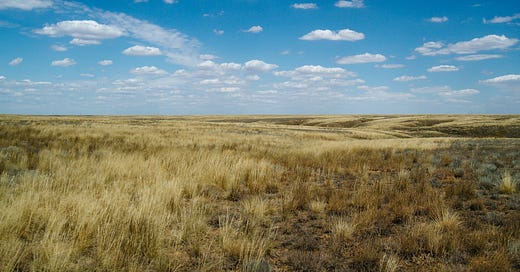Once upon a time, many, many years ago (like 600), there lived a group of people in southern Ukraine who struggled to find their place in society. They were called the Cossacks. The word Cossack comes from the Turkic word kazak which means “free man.”
These societal misfits banded together, living in the steppes (aka Ukrainian grasslands). They practiced trades like hunting, fishing, and the collection of salt and pepper.
The Ukrainian grassland, aka steppe
Life wasn’t all hunting and gathering, however. There was constant threat from the Tatars, great warriors who were trying to penetrate Ukraine. The Cossacks would regularly go to battle, fighting to retain their territory.
When they would get back from battle, the story goes, they would perform an improvisational dance called the hopak. Hopak comes from the word hopaty, which means “to leap and stamp one’s feet.”
Just like the name implied, the hopak was athletic, with lots of squats, leaps, and stretches on the ground and in the air. It was a competition of sorts between the participants, with one dancer trying to out dance the other (Imagine the dance off scene in Zoolander, just with different clothes and more impressive moves.)
The dance was originally performed only by men, though eventually it expanded to involve women as well.
Kind of like knees over toes, except faster and more dynamic.
The Cossack squat that is frequently taught in exercise and movement settings today comes from this style of dancing.* The fact that it was improvisational in nature implies there were many ways to perform a Cossack squat within the realm of the dance.
*The Russians also have a similar style of dance called the squat dance that appears to have originated later.
Its origin also suggests the Cossack squat wasn’t repeated for sets and reps. It wasn’t an exercise; instead it was a transition, a temporary moment in space before the dancer moved into something else.
The next time you perform a Cossack squat, try it with the intention of using it as a temporary position rather than an exercise. Does it change how you do it?
Example:
Some things:
I recently chatted with movement teacher Carrie Owerko, about practice, play, and learning. There were so many gems and insights in this two part episode; if you are interested in movement, it’s worth a listen. Episode one. Episode two.
If you read the book, “Let Me Introduce You,” and are interested in diving into the concepts from the book more fully, Adarian Barr and I will be co-leading a four week book club beginning Tuesday, September September 19 at 7:30AM PST. I don’t know if we will do it again, and we are limiting it to 10 participants. You can find out more (or register) here.
Wishing you a very happy end of summer.
Warmly,
Jenn




Love the the beautiful tie-in of the origin story to the exploratory prompt. 👏